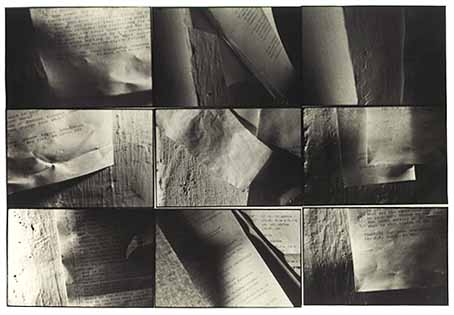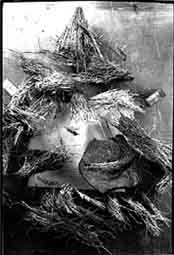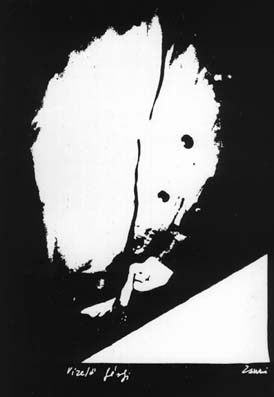
István Halas: The answer, 1987
PREFACE
One day in April 1987 I received a telephone call
by László Beke, he asked me, if I had time on that evening. I had time
and so we went to the "Budapest-Fotoclub", where Dr. Gerlinde Schrammel
was talking about "Contemporary Austrian Photography".
The topic of the report was more interesting
than the Photoclub, where the address was delivered. Later we went somewhere,
talking about experiences, opinions, but never about photography. The next
day we visited some exhibitions and I showed to Gerlinde some former works
exhibited formally in the Liget-Gallery and works of my own collection
and, of course I presented various catalogues and journals.
I was afraid to ask for helping to realize exhibitions
by Austrian artistas, because I did'nt know whether she liked Liget's activities
or she was just polite.
At the moment, John and I, we are sitting in
a pub near the Gallery. He is writing about the Liget.
Soon the opening of an exhibition by Polish photographers
is ready. In meantime, a friend of mine has arrived and we pass the time
waiting for Gerlinde coming from Vienna.
Finally, a few words about this topic: from the
relationship between Fotogalerie Wien and Liget-Gallery two exhibitions
have emerged so far: one in November 1987 "Heinz Cibulka"
and another one in March 1988 "Michaela Moscouw" for
which I am very grateful and I hope that this cooperation will continue.
And now a few remarks about Liget-Gallery: All
advantages and qualities arise from its disadvantages. The most important
quality is the "imbreeding" and the cooperative acting and thinking.
Exhibitions, concerts, speeches and other events
do not address to a small number of selected individuals but only to ourselves.
Of course, there were a lot of important events, but in my opinion, these
events which are important fot us bring good resoults provided that we
ourselves change through them and that they don not change us.
When I walk to my friends, we do not talk about
past and future exhibitions, and not about visitors and cooperation; for
the Liget-Gallery everything is indifferent, temporary, sometimes we stay
together talking about this only occasionaly. I am not the director, but
directed. And this last butnot least, because people working and exposing
here and I myself, we do not depend on materialistic interests such as
money, prestige or other things.
Tibor Várnagy,
directed by the Liget-Galeria
.
.
John P. Jacob:
HUNGARIAN PHOTOGRAPHY - NO TITLE
I came to Budapest in 1986 to prepare an exhibition
of photography by artists from Eastern Europe that I had been working on
since 1983. More than 100 artists from throughout Eastern Europe
, Yugoslavia and the USSR responded to the invitation to participate, but
the
exhibition, held at the Liget-Galéria, was "mixed-bag" of photographic
prictices, revealing both the amazing diversity of creative activities
in these nations and my own ignorance of the traditions and conditions
which underscore these activities. Since that time I have travelled often
in Hungary, Czechoslovakia, the DDR and Poland, meeting with the artists
I have come to know here. Their almost relentless program for de-mystifying
my Western conceptions of what exactly constitutes an Eastern European
artist has been invaluable to their progress of my project, as well as
my growth as a thinking, understanding human being.
A similar program is available to viewers of
this exhibition. Do not look for concensus, a similarity of style, in these
photographs. Note, rather, the remarkable diversity of both ideas and manipulations
of the photographic medium. An aesthetic philosophy, such as divides and
informs much Western photography into "given" genres such as photojournalism,
portraiture, documentary and so forth, cannot be applied to these works.
The freedom from such "Art World" constrains should be regarded not as
an affront to the viewers concepts of photoaesthetics, but as an emancipation
from pre-conceptions. The rejection of concensus in these works is an invitation
to experimentation from which we can benefit considerably.
Six months after my first
visit to Budapest, I returned with the possibility to curate an exhibition
of Eastern European photography in the United States. To collect accurate
information about these artists' works for a text to accompany the exhibition,
I prepared a list of thirty-six questions, and handed them out to each
artist. One artist answered the questions. Several others laughed at them.
Istvan Halas made a photographic series from

them, but didn't send it to me until after my
text had already been written. The experience was humiliating (they continue
to laugh about it today...). It was also my first real moment of pure understanding
of these artists and their works. How, after all, could such a list, even
with so many questions, possibly shed light on these works? It could only
seek concensus where none exists, imposing uniformity where, in fact,
categorization is defiantly rejected. Today, the greatest influence on
my own photographs is the independence theat I have learned here in Hungary.
.
The old Hungarian tradition in photography known
from artists like Kertész, Moholy-Nagy, Kepes, Capa, Brassai and so on,
had, continuity in spite of the 2nd world war and the period afterwards.
One of the causes of this continuity is the great enthusiasm for photography
in this country. It is shown also in the Hungarian artists' attempt to
keep themselves informed about art and photography. Contrary to the photographic
situation in Western Europe and in the USA, in Hungary exists an "Official
Photography". This photography is supported by different organisations
and promoted by exhibitions.
In addition, there exists an "Underground-Photography"
called by John P. Jacob also "Private Photogrphy"(1), whose artists - and
I adopt the word "artist" on purpose - contemplate photography and make
use of it in different ways.
The origin of this experimental photography is
in the sixties, when for the first time actions were started by artists
and performers like Miklós Erdély and Tamás Szentjóby. Probably, the work
by the essayist Béla Hamvas has a certain importancein the development
of the experimental and actionistic movement.(2)
In the seventies the actions and performances
by Tibor Hajas, who was killed in a car-accident
in 1980, were of basic importance for photography. Hajas is cultivating
an intelectual way of actionism, which reminds the Viennese Rudolf Schwarzkogler,
although different in many ways, so for example, with regard to the contens.
Tibor Hajas arranges his actions in the sense of the question for "what
EXISTS" and puts it in contrast to the possibility of perception and "what
we SEE".
Photography becomes an integrated part of his
actions and "mise en scéne" and, from progressing documentation to perception,
it becomes an autonomous form of artistic expression.
Often, the young János Vető
was working together with Hajas and as a consequence always confronted
with painting, he arrives at his personal modus, using photography in his
stillifes.

Kina Vető: Don Quijote, 1987
Strange objects are interpreted in a different
way and transformed into dramatic sceneries, but always with a smile.
András Baranyay, coming from painting and graphics
uses obviously photography as an enlargement of this graphical technincs.
Significant for him is the formal aspect, also in the detail. An exemple
are the hand-studies, he has developped since the sixties. His self-portrait-series
dated 1979 is known and famous, showing the relation between certainty
by form - the stripes of the shirt as point of rest - and uncertainty by
movement, which covers nature until reaching almost anonymity revealing
it at the same time.
Movement is also emphasized in the work by Gábor
Kerekes, which shows a visualistic tendency in his "Subjective" Photography.(3)
The international reknown photographs by Kerekes
are the pictures of cities and architecture containing a "dematerialized".
By means of diaphragm-aperture it is possible
to catch a continuing movement, which seems to be a process of ageing.
In these pictures we see the same impression of decadence one often finds
in towns.
A photographer working with high perfection and
sensuality for perfect photos is Attila Vécsy. Also for him movement is
an important part of his work, similar to Kerekes.
Árpád Fákó, a representative
of the young Hungarian generation of photographers is also influenced by
actionism and performance. He is transforming his "mise en scéne" in a
conscious, subjective and experimental way giving them a frivolous touch.
An example is the series "Fish-Smile" dated 1984.
Remarkable in the Hungarian situation of photography
and, in contrary to Western countries, especially Austria, is the small
number of female photographers.

Zsuzsanna Ujj: Urinating Man (1988)
Zsuzsanna Ujj and Lenke Szilágyi are exceptions:
two woman different in nature and work.
Zsuzsanna Ujj is performing,
photographing, making music, singing and writing. Her photos influenced
by actionism and performance, express, in contrary to these moved forms,
a static, often unreal silence:
a body, a face stopped abruptly in motion.
Lenke Szilágyi
is the typical representative of "Subjective" photography. Her works resoult
spontaneously from her environments with her special point of view. It
seems to be staged, but it is false. Lenke has not fixed on a certain subject,
she remains subjective.
Tibor Zátonyi, also a representative of "Subjective"
photography, focusses on documentation comparable with West German Subjective
Photography of the seventies.
We can find good knowledge of photography of
the last two decennies in West Europein the works by István
Halas. This artist and photographer elaborates his townscapes and interiors
in a subtil and intellectual way transforming his own impression to a formal
expression. He uses parts of the pictures on other creating "tableaux"
with an alterated statement.
Tibor Várnagy deserves a special place in the
Hungarian Avantgarde Scene and not only for his merits as exhibitor and
gallerist. Above all, Tibor is working as an artist in the visual experimental
fieldof photography, where movement and contingency of situation are very
important. Typical for his oeuvre is the simultaneous working with picture
and letters, whereby the content of text is less important. With this connection
of word and image he is close to famous artists such as Duane Michals,
Christian Vogt, Bodo Hell, Peter Dressler etc, but with difference, that
Várnagy is using letters and words as a part of the composition of his
pictures; his xerox-books are a tipical example.
Tibor Várnagy represents a style he refers to
SCHNASS, also in the Liget-Gallery (the only gallery in Budapest, which
is exposing experimental avantgarde). Translated as "trifling, less than
important". Schnass will be understud as an experiment to create unique
and humorous artworks in relation to high sophisticated ideas and low material
quality.(4) Also, the oeuvre by Várnagy should be understood in such a
way.
Interesting for the photographic avantgarde in
Budapest - which I can treat in this catalogue only partly - is the closeness
to to past actions and performances, wereby it has not visualized a repetition,
but a development to release and liberty.
Performance-art as a total artwork, where the
documentation becomes a very important and essenttial part, which - liberated
from the origin - gains independence as artwork.
Perhaps, just Schnass is the basis for this positive
evolution.